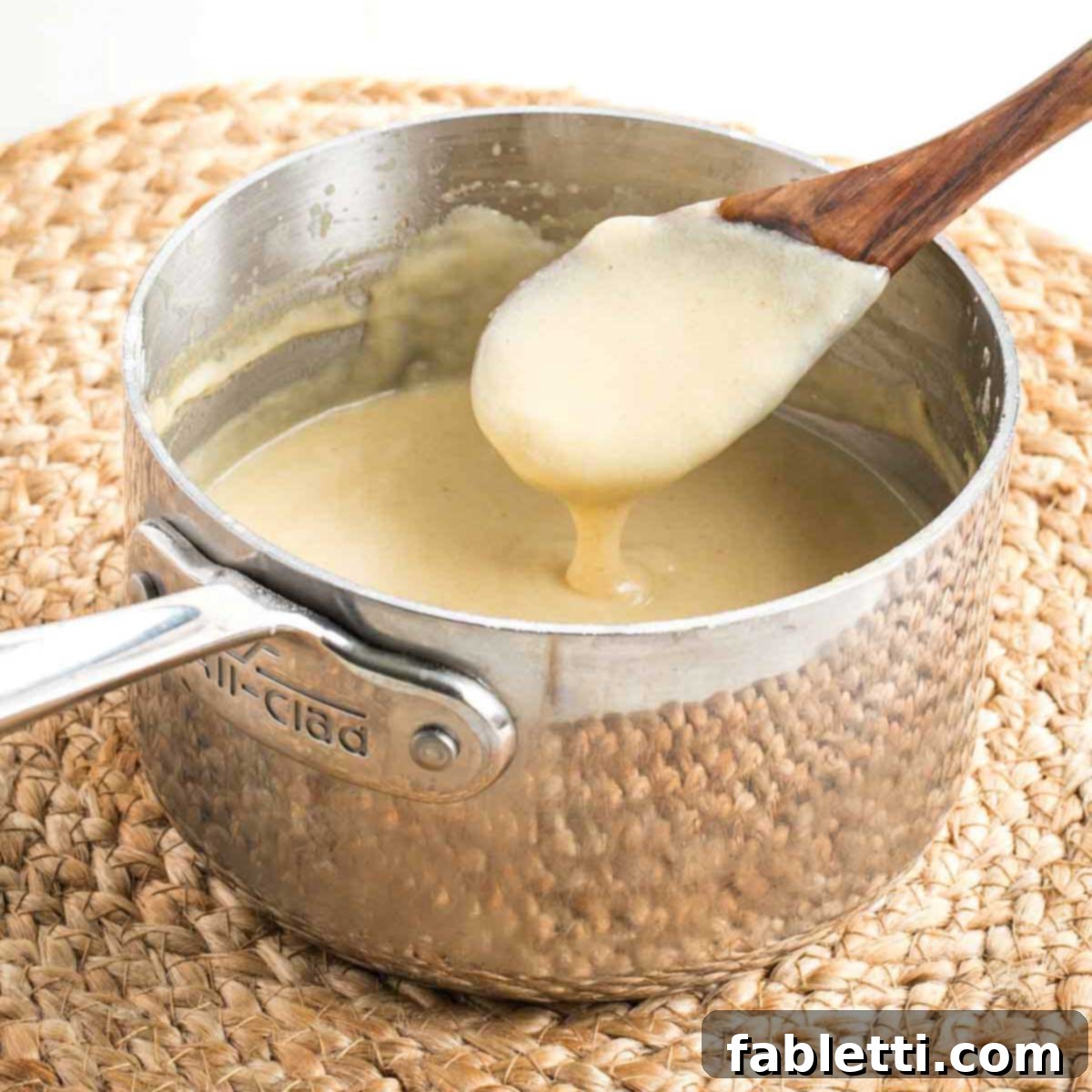The Ultimate Vegan Bechamel Sauce: Creamy, Dairy-Free, and Gluten-Free Perfection
Transform your culinary creations with this exquisite Vegan Bechamel Sauce, a dairy-free and gluten-free masterpiece that redefines classic comfort. Infused with a secret ingredient – savory miso paste – this white sauce offers an irresistible depth of flavor and a silky-smooth texture that will elevate any dish. Crafted from wholesome ingredients like rich olive oil and versatile cassava flour, it ensures that everyone, regardless of dietary restrictions, can indulge in creamy goodness. Say goodbye to dull, restrictive cooking and hello to a world of delicious possibilities for your favorite recipes, from hearty vegan lasagna and comforting pot pies to any pasta dish craving a luxurious white sauce.
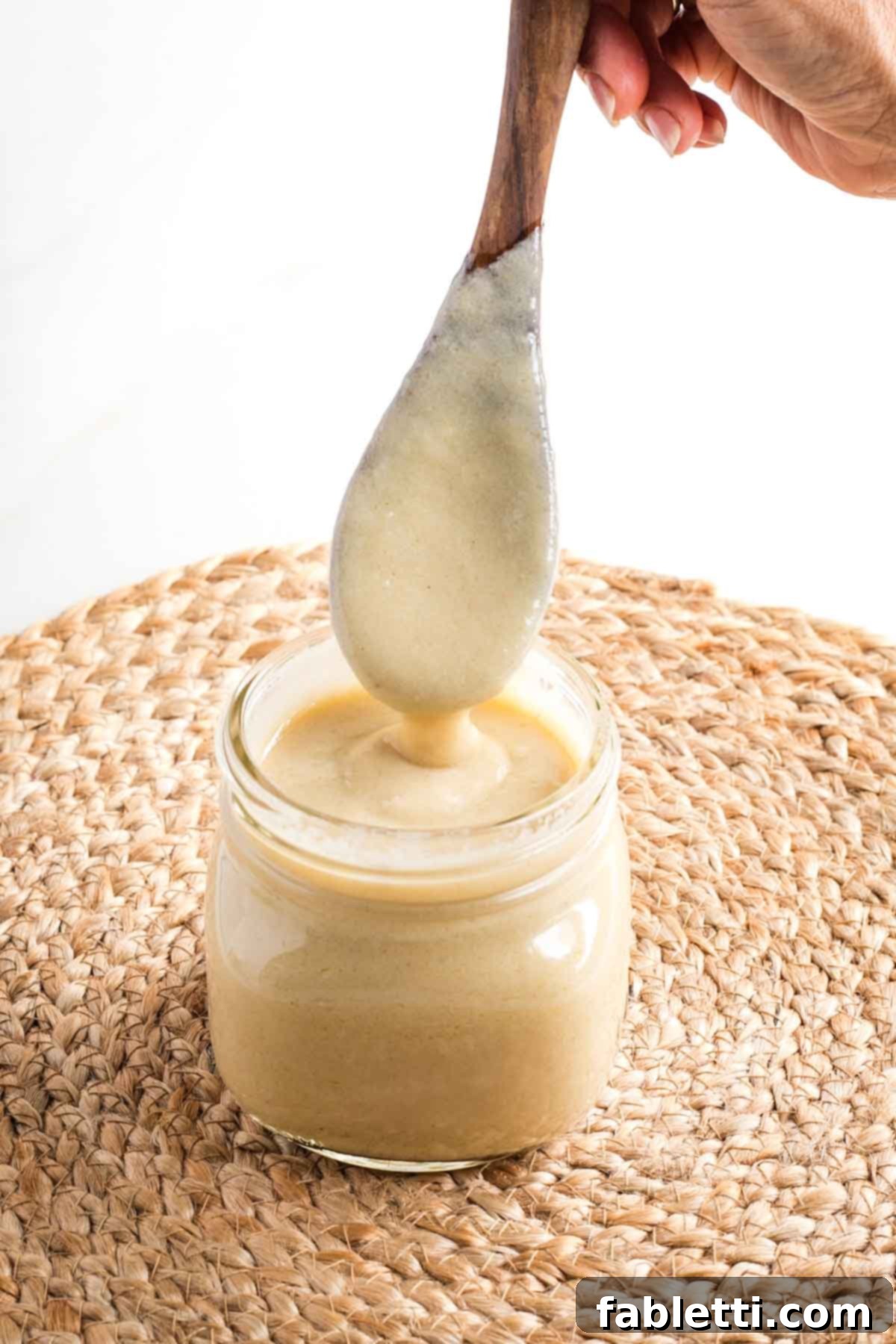
Béchamel sauce, often hailed as one of the “mother sauces” of French cuisine, forms the foundational backbone for countless beloved dishes. Traditionally made with butter, flour, and milk, it provides a rich, creamy base that’s essential for everything from gratins to creamy pasta. However, for those navigating gluten sensitivities or dairy allergies, enjoying this classic can be a challenge. That’s where this revolutionary vegan white sauce comes in! It captures all the luxurious thickness and creaminess of its traditional counterpart, ensuring that a gluten-free or dairy-free diet doesn’t mean compromising on flavor or texture. This recipe offers a fantastic alternative that truly tastes and feels authentic, opening up a world of culinary enjoyment for everyone.
Why This Vegan Bechamel Will Become Your Go-To
This isn’t just a substitute; it’s an enhancement. Our vegan bechamel boasts several compelling reasons to become a staple in your kitchen:
- Naturally Vegan & Dairy-Free: Crafted with nutrient-rich olive oil and creamy cashew milk, this sauce is entirely plant-based, making it perfect for vegans and those avoiding dairy. It offers all the richness without any animal products.
- Effortlessly Gluten-Free: By utilizing cassava flour, we achieve a perfectly smooth and thick white sauce that is completely gluten-free. This ensures that individuals with gluten sensitivities or Celiac disease can enjoy classic dishes without worry.
- Unbeatable Flavor Profile: The inclusion of miso paste adds an incredible layer of umami – a savory depth that traditional bechamel often lacks without the addition of cheese. This secret ingredient truly elevates the flavor, making it irresistible.
- Quick & Easy Preparation: Despite its gourmet taste, this sauce comes together in just about 10 minutes, making it an ideal choice for busy weeknights or when you need a quick flavor boost for your meals.
- Incredibly Versatile: Use it as a standalone sauce for pasta, as the creamy binder in lasagnas and gratins, or as a rich base to build more elaborate sauces tailored to your specific taste.
- Dietary-Friendly: Beyond being vegan and gluten-free, the use of wholesome ingredients makes it a healthier choice without sacrificing an ounce of deliciousness.
Key Ingredients & Smart Substitutions
Crafting this exceptional vegan bechamel relies on a few simple, yet powerful ingredients. Each plays a crucial role in achieving that perfect creamy texture and unforgettable flavor. Here’s a closer look at what you’ll need and how you can adapt the recipe to your preferences:

- Plant-Based Milk: For unparalleled creaminess, I recommend using cashew milk. Its natural richness and neutral flavor provide an excellent foundation. You can easily make your own (check the recipe card for a simple guide!) or use a good quality store-bought brand. Other excellent dairy-free choices include unsweetened soy milk, oat milk, or almond milk. Ensure your chosen milk is plain and unsweetened to avoid altering the savory profile of the sauce.
- Miso Paste: This is our secret weapon for adding incredible depth and umami. Light miso paste is the preferred choice as it imparts a subtle, savory complexity without overpowering the sauce. It beautifully mimics the rich, savory notes typically contributed by butter and cheese in traditional bechamel, making your dairy-free version truly stand out.
- Olive Oil: Essential for creating the roux, olive oil provides a healthy fat base and a lovely subtle flavor. If you’re aiming for an entirely oil-free sauce, you can create a clever substitute: whisk together 1 tablespoon of drippy tahini with 3 tablespoons of vegetable broth until you achieve a uniform, creamy texture. Use this mixture in place of the olive oil. While it might result in a slightly less rich consistency, it still yields a delicious plant-based bechamel.
- Gluten-Free Flour: Cassava flour is an excellent gluten-free option for this recipe, providing a smooth texture without a gritty aftertaste. However, you can also use any all-purpose gluten-free flour blend that meets your dietary needs. For those without gluten restrictions, regular all-purpose flour works perfectly fine. Sourcing quality dry goods, like flour, is important for consistent results – I often rely on suppliers like Thrive Market.
- Seasonings: A touch of sea salt, a dash of white pepper (chosen for its subtle flavor and to maintain the sauce’s pristine color), and a pinch of nutmeg complete the classic bechamel flavor profile, adding warmth and aromatic depth.
Step-by-Step Guide: Crafting Your Perfect Vegan Bechamel
Making this vegan bechamel sauce is straightforward, but it does require your full attention and a bit of patience – mainly in the form of constant whisking! The entire process takes approximately 10 minutes, and the effort is well worth the incredibly creamy and flavorful result.
1. Prepare Your Roux

Begin by heating the olive oil in a small saucepan over medium-low heat. Allow the oil to warm for about 30 seconds. Once warm, sprinkle in the cassava flour evenly. This combination of fat and flour is known as a roux, the thickening agent for our sauce. Immediately start whisking vigorously.
2. Cook the Roux
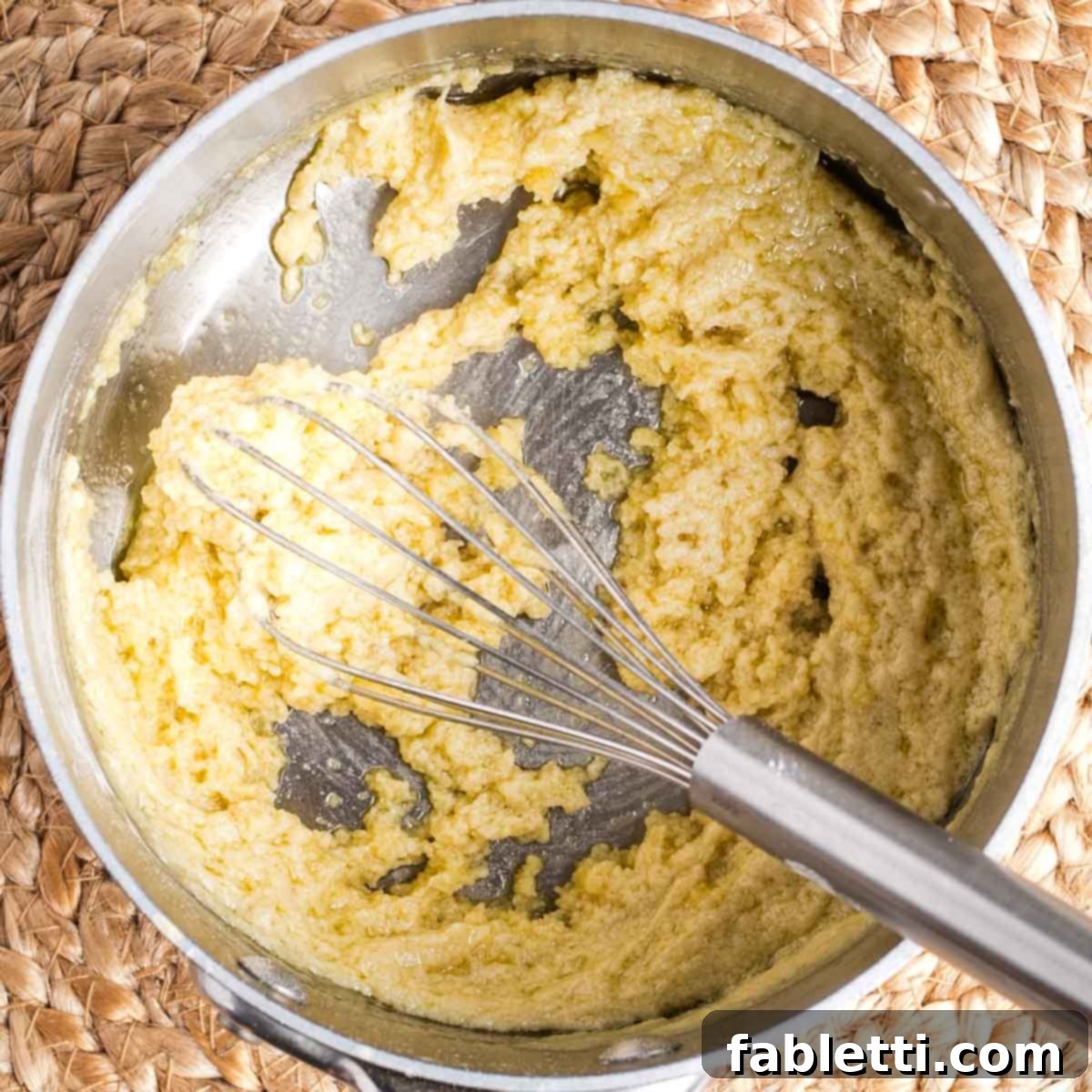
Continue to whisk constantly as the flour cooks off its raw flavor. This is crucial for a smooth-tasting sauce. Do not let the roux turn brown; we want a pale, creamy white sauce. The mixture will quickly become very thick and pasty, often getting caught in the whisk – this is perfectly normal and a sign you’re on the right track.
3. Build the Creamy Base
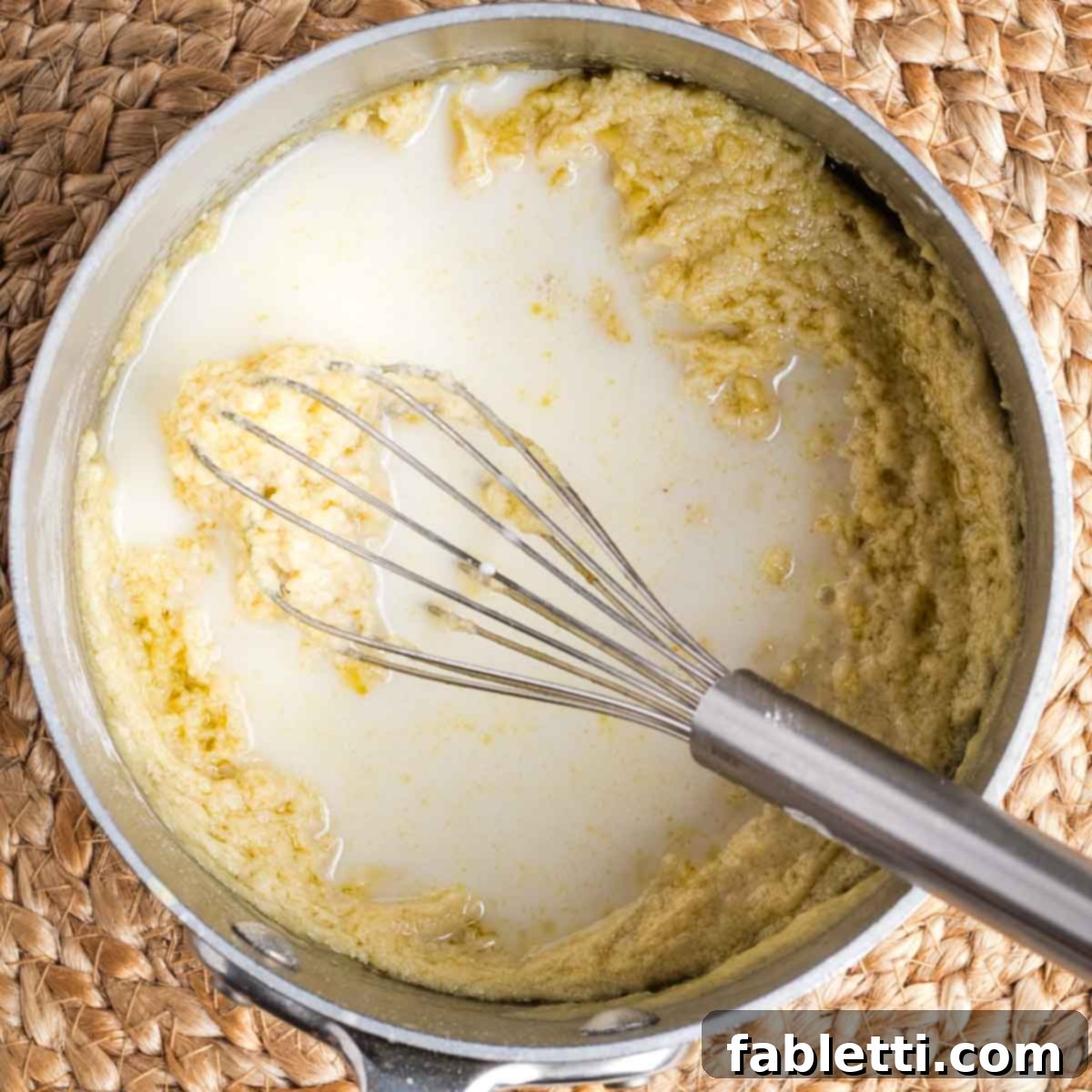
Pour in just a couple of tablespoons of the plant milk and immediately whisk until a uniform, thick texture is achieved. The mixture might seize up and become even thicker, which is expected. Raise the heat slightly to medium. Continue to add the remaining liquid slowly, a few tablespoons at a time, whisking continuously between each addition. This gradual approach is key to preventing lumps and ensuring a smooth emulsion.
4. Achieve Velvety Smoothness
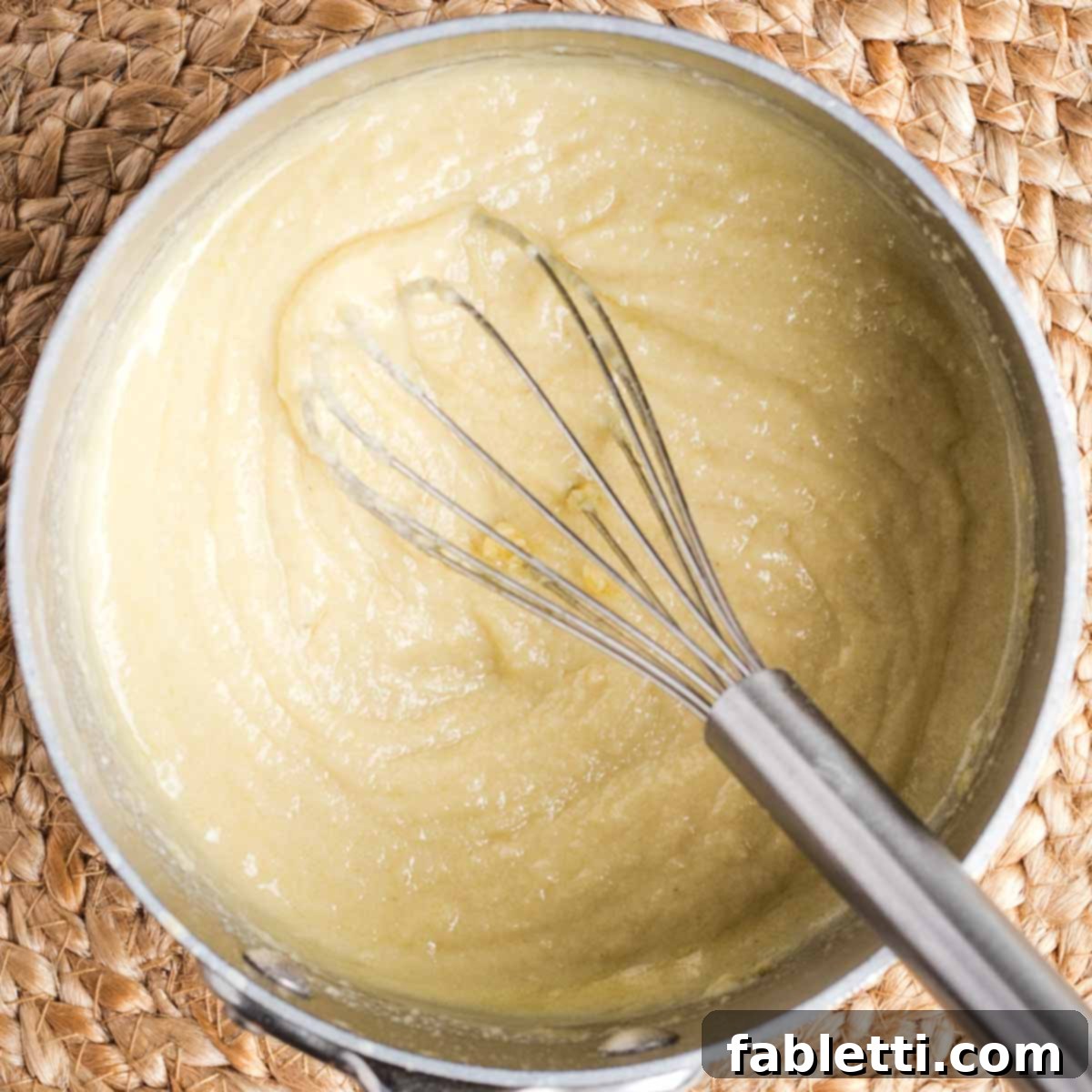
As you add the milk incrementally, you’ll notice the sauce oscillating between being very thick and then thinning out as the new liquid is incorporated, only to thicken up again as it heats. The sauce should visibly thicken after each addition. If it’s not thickening, gently increase the heat. Keep adding small amounts of milk, whisking constantly, until you have only ¼ cup of milk remaining.
5. Infuse with Umami
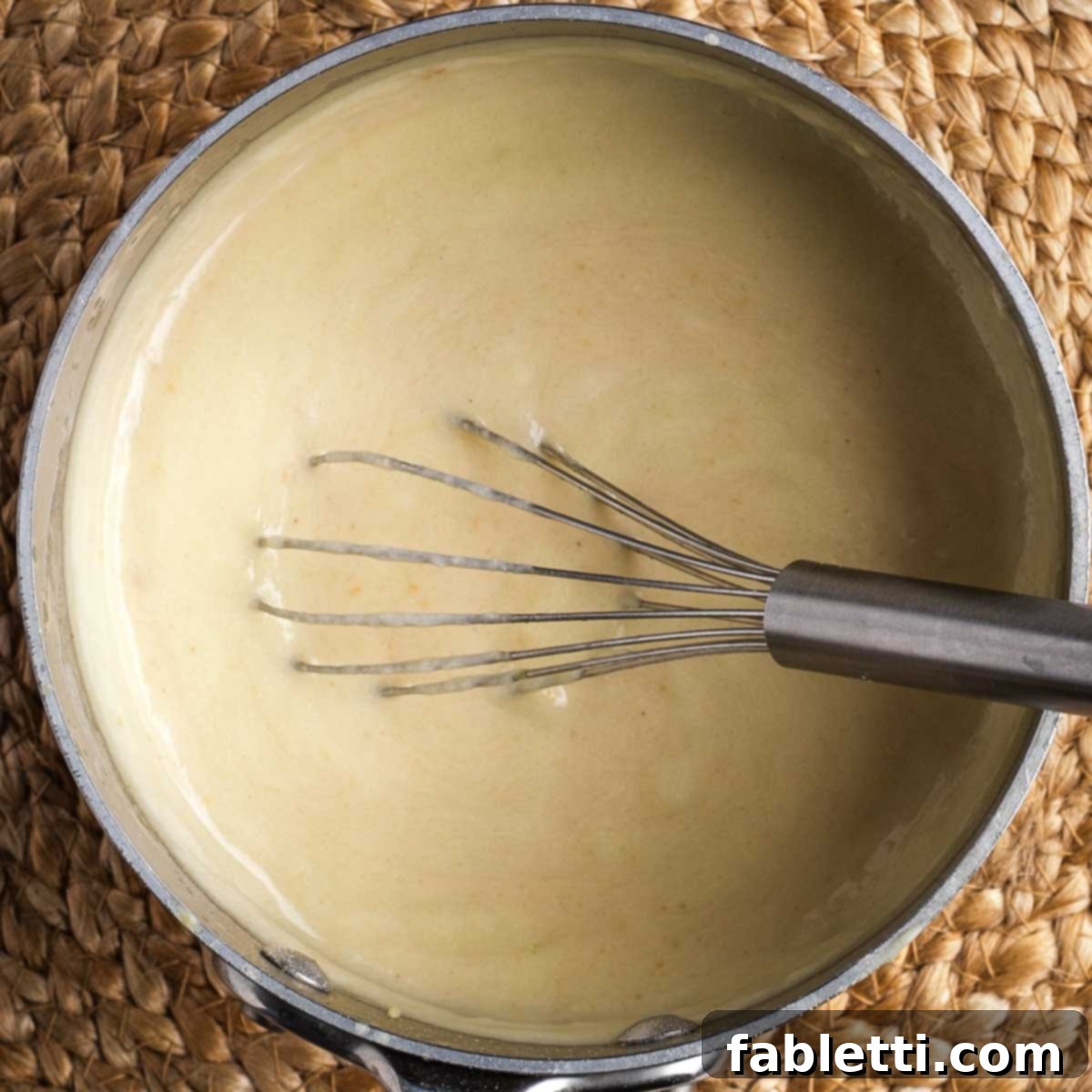
With the last ¼ cup of milk, use a fork to thoroughly mix in the miso paste until it’s completely diluted. Then, incorporate this miso mixture into the sauce, continuing to whisk vigorously until the last addition thickens the sauce to your desired consistency. The miso will seamlessly integrate, adding a fantastic layer of savory richness.
6. Final Seasoning
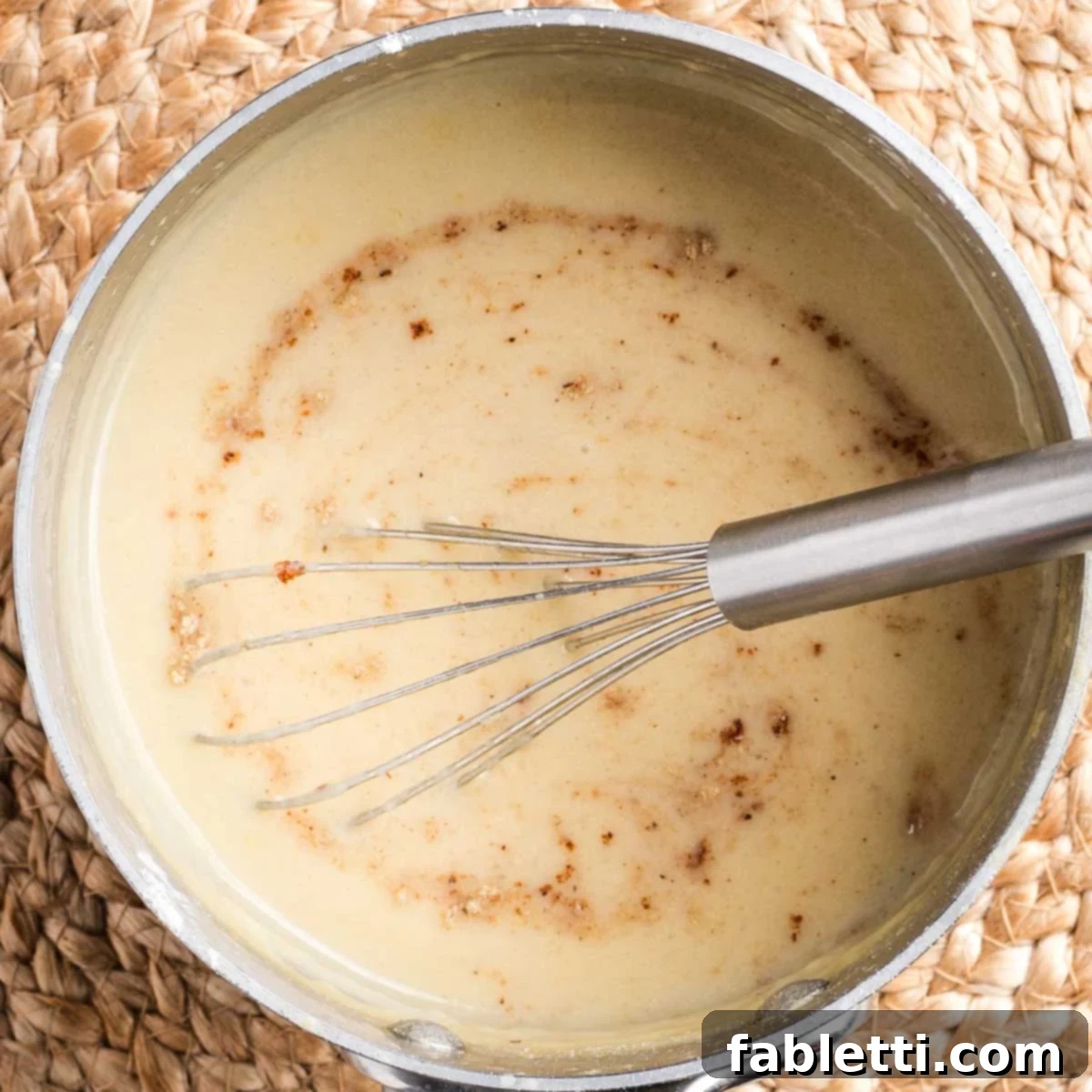
Once the sauce has reached its optimal thickness and the miso is fully incorporated, turn off the heat. Stir in the sea salt, white pepper, and a pinch of nutmeg. Taste and adjust seasonings as needed. The sauce should be thick enough to generously coat the back of a spoon, leaving a clear trail when a finger is drawn across it.
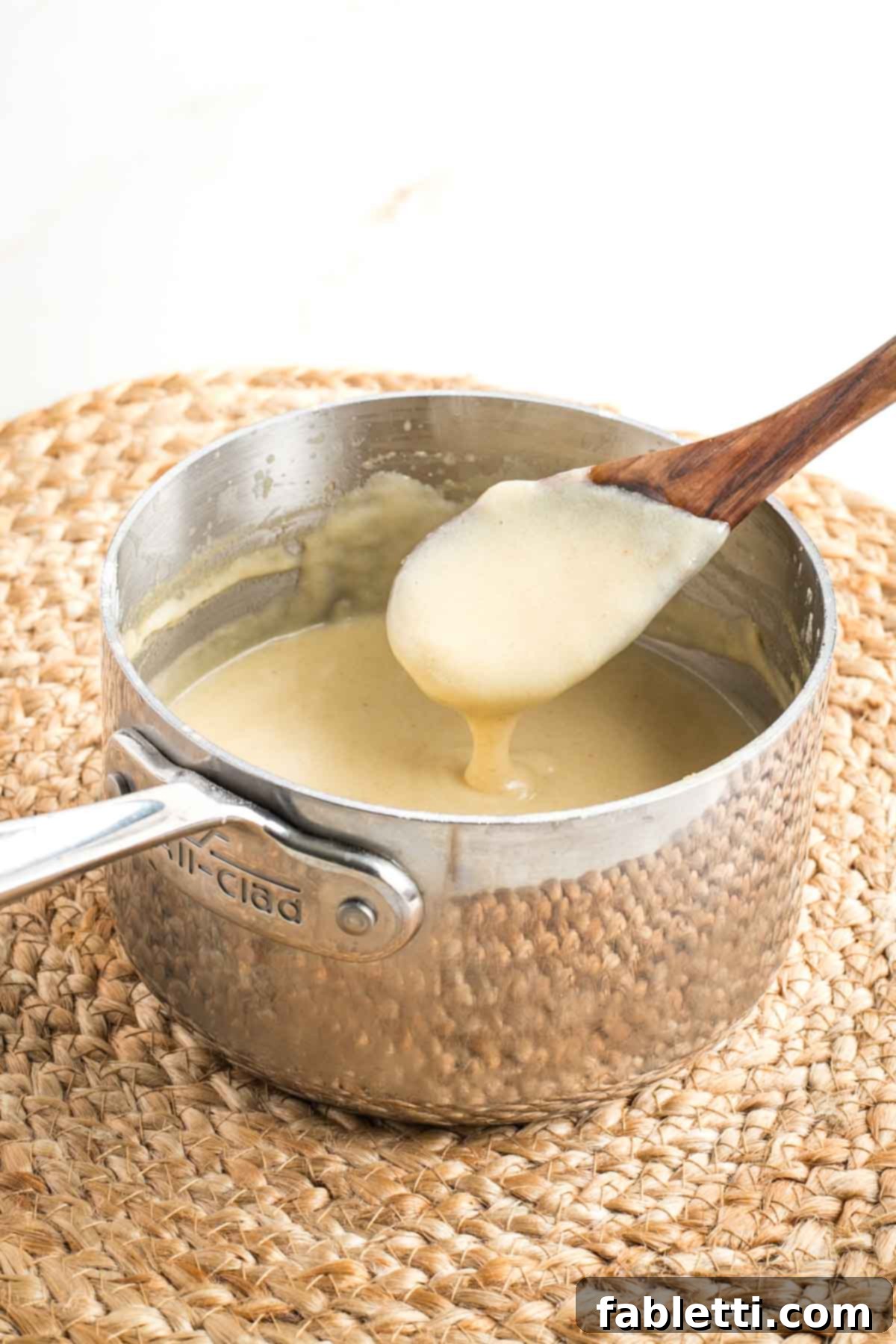
As the finished bechamel sauce cools, stir it occasionally to prevent a skin or film from forming on the surface. This ensures it remains perfectly smooth until you’re ready to use it.
Expert Tips for Bechamel Perfection
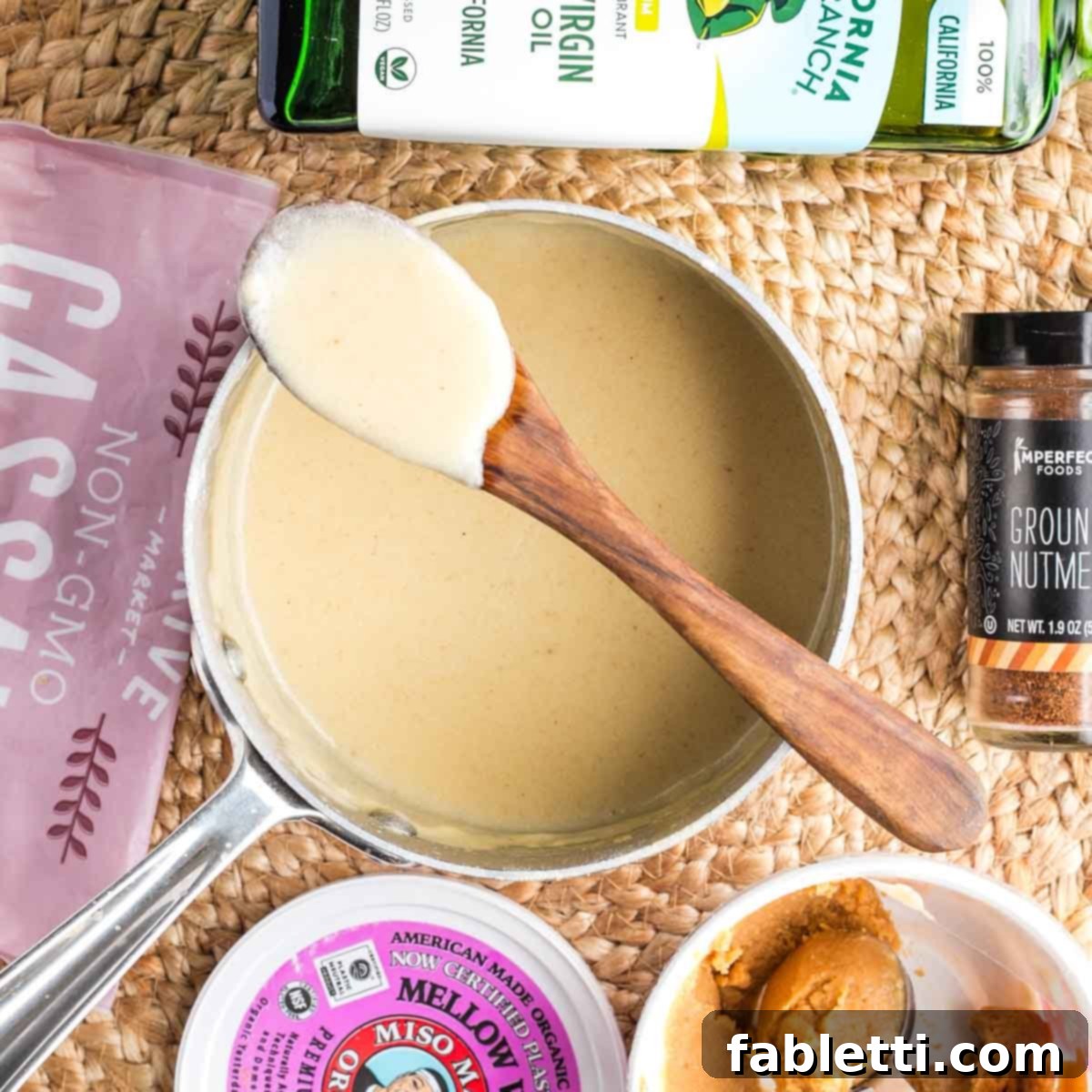
Achieving a truly outstanding vegan bechamel is simple with these pro tips:
- Mise en Place is Key: Before you even turn on the stove, gather and measure all your ingredients. This sauce comes together quickly, and having everything ready by your side prevents scrambling and ensures a smooth process, especially since you’ll be whisking almost constantly.
- Whisk, Whisk, Whisk: I cannot overstate the importance of constant whisking. This is your primary tool for preventing lumps, ensuring even cooking of the flour, and creating that signature silky texture. Don’t stop whisking until the milk is fully incorporated and the sauce is perfectly smooth.
- Temperature Matters: Using cold milk can shock the roux, making it prone to lumps. It’s best to use plant milk that is at room temperature or even slightly warmed. This allows for a smoother, more gradual incorporation and a lump-free sauce.
- Adjust Heat as Needed: While starting on medium-low is ideal, don’t be afraid to adjust the heat up slightly as you add the milk. A gentle simmer helps the sauce thicken, but avoid a rapid boil, which can cause scorching or uneven cooking.
- Taste and Adjust Seasoning: Always taste your sauce before serving and adjust the salt, pepper, and nutmeg as needed. Remember that miso paste is savory, so factor that into your salt additions.
Serving Suggestions & Culinary Uses
The versatility of this Vegan Bechamel Sauce is truly remarkable. Once you master it, a world of dairy-free and gluten-free culinary possibilities opens up:
- Classic Comfort Dishes: This bechamel is the perfect base for traditional favorites. Think creamy, layered lasagna with rich vegetables, luscious vegan macaroni and cheese, or comforting pot pies with a golden, bubbly top.
- Gratins and Bakes: Use it to bind and enrich vegetable gratins, potato bakes, or even a classic croque monsieur (veganized, of course!). Its creamy texture adds a luxurious mouthfeel to any baked dish.
- Pasta Sauces: Beyond simple pasta, it can be the foundation for a creamy alfredo-style sauce, a rich carbonara, or any pasta dish that calls for a silky white sauce. Add roasted vegetables, herbs, or nutritional yeast for extra flavor.
- Creamy Soups and Stews: Stir a ladle or two into vegetable soups or stews towards the end of cooking to add body and a touch of creamy indulgence.
- Dipping Sauce: Serve it warm as a dipping sauce for roasted vegetables, vegan nuggets, or crusty gluten-free bread.
- Mornay Sauce Alternative: For those missing a cheesy sauce, simply stir in some nutritional yeast and a pinch of garlic powder to transform this bechamel into a delightful dairy-free Mornay-style sauce.
Storage & Meal Prep
This vegan bechamel sauce is excellent for meal prep, allowing you to have a delicious, ready-to-use sauce on hand. Proper storage ensures its freshness and quality:
- Cool Completely: Always allow the sauce to cool completely to room temperature before transferring it to storage containers. This prevents condensation from forming, which can affect texture and promote bacterial growth.
- Airtight Containers: Store the cooled sauce in airtight containers to protect it from air and odors in the refrigerator or freezer. Mason jars are an excellent choice.
- Refrigeration: When made with homemade cashew milk, this vegan bechamel will stay fresh in the refrigerator for up to a week. If you use store-bought plant milk with preservatives, it may last a bit longer, but I have not specifically tested for exact timing.
- Freezing: For longer storage, this sauce freezes beautifully for up to 3 months. When freezing in mason jars, remember to leave a couple of inches of space at the top to allow for expansion.
- Portioning for Convenience: To make meal prep even easier, you can use Souper Cubes to freeze the sauce in ½ cup, 1 cup, or 2 cup portions. Once frozen solid, pop them out and transfer them to freezer-safe zip-top bags to save space.
- Reheating: Thaw frozen bechamel in the refrigerator overnight. Reheat gently in a saucepan over low to medium heat, whisking constantly. If the sauce is too thick, add a splash of extra plant milk or vegetable broth until it reaches your desired consistency.
Frequently Asked Questions (FAQs)
Is this bechamel really gluten-free and dairy-free?
Yes, absolutely! This recipe is specifically designed to be both dairy-free (using plant-based milk and olive oil) and gluten-free (using cassava flour). It’s perfect for those with allergies or dietary preferences.
Can I make this sauce oil-free?
You can! For an oil-free version, replace the olive oil with a mixture of 1 tablespoon drippy tahini whisked with 3 tablespoons vegetable broth. While the texture might be slightly less rich, it still yields a delicious plant-based white sauce.
What if my sauce is lumpy?
Lumps usually occur if the milk is added too quickly or if you don’t whisk constantly. If your sauce is lumpy, don’t worry! You can try straining it through a fine-mesh sieve or, for a super smooth result, carefully transfer it to a blender and blend until silky. Reheat gently after blending.
Can I use other types of miso?
Light miso (white or yellow) is recommended for its milder, sweeter flavor that blends seamlessly into the sauce. Darker miso varieties (red or brown) have a much stronger, more pungent flavor that might overpower the delicate notes of the bechamel.
Did you know commenting and rating recipes is one of the best ways to support your favorite food bloggers? If you made this recipe, please consider leaving a five-star rating below and a comment. Also, please share your photos on Instagram by tagging me @dkhealthcoach and using the hashtag #debraklein!
📖 Recipe
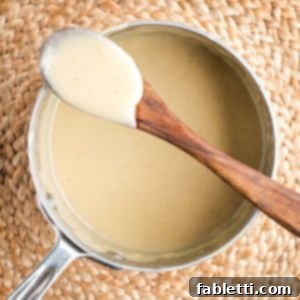
Vegan Bechamel Sauce
Rate this Recipe
Pin Recipe
Equipment
- Small Sauce Pan
- OXO Good Grips 11-Inch Balloon Whisk
Ingredients
- ¼ cup olive oil
- ¼ cup cassava flour
- 2 cups cashew milk
- ½ teaspoon sea salt
- ⅛ teaspoon white pepper
- pinch nutmeg
- 1 tablespoon light miso
Instructions
- Heat a small saucepan over medium-low heat. Pour in the olive oil and allow it to warm for 30 seconds.
- Sprinkle in the cassava flour and whisk constantly to form a roux. Continue whisking to cook off the raw flour flavor, being careful not to let it brown. The mixture will become very thick and pasty at this stage, often sticking to the whisk.
- Gradually whisk in 2 tablespoons of the plant milk. The mixture may thicken further. Continue to pour in additional milk, a few tablespoons at a time, whisking continuously after each addition until the liquid is evenly absorbed and the sauce thickens. Use all but ¼ cup of the total milk.
- Observe the sauce’s consistency as you add the milk: it will fluctuate from thick and pasty to smooth and creamy. Each new addition of milk will thin it out initially, but as it heats and is absorbed by the flour, it will thicken again. Repeat this process with each small addition.
- For the final ¼ cup of milk, add the miso paste and use a fork to thoroughly dilute it. Then, add this miso-milk mixture to the sauce and whisk until it is fully incorporated and the sauce has reached your desired consistency. Turn off the heat.
- Stir in the sea salt, white pepper, and nutmeg. Stir the sauce occasionally as it cools to prevent a skin from forming. Transfer to an airtight container and store in the refrigerator for up to a week, or in the freezer for up to 3 months.
Notes
Olive oil: For an oil-free bechamel, substitute the oil with vegetable broth. While the finished product may be slightly less rich and creamy, it still provides a solid plant-based version of bechamel.
Milk: Use unsweetened cashew milk, soy milk, oat milk, or almond milk. Ensure it’s plain and unflavored.
Make your own cashew milk: Soak ½ cup raw, unsalted cashews in boiling water for 30 minutes. Rinse, drain, and add to a blender with 2 cups of fresh water. Process until completely smooth and creamy.
Serving size: Nutrition information was calculated based on one recipe yielding 2 cups of bechamel sauce and a serving size of ¼ cup.
Nutrition
Note
The nutrition calculations were done using online tools. To obtain the most accurate representation of the nutritional information in any given recipe, you should calculate the nutritional information with the actual ingredients you used. You are ultimately responsible for ensuring that any nutritional information is accurate, complete and useful.
